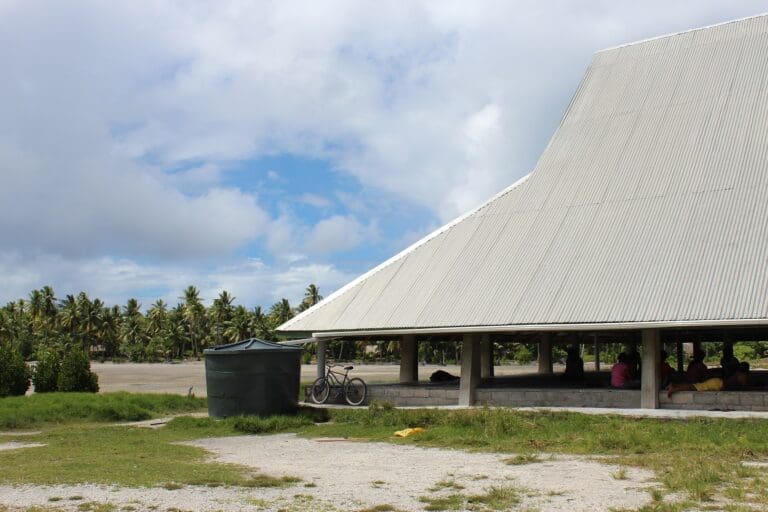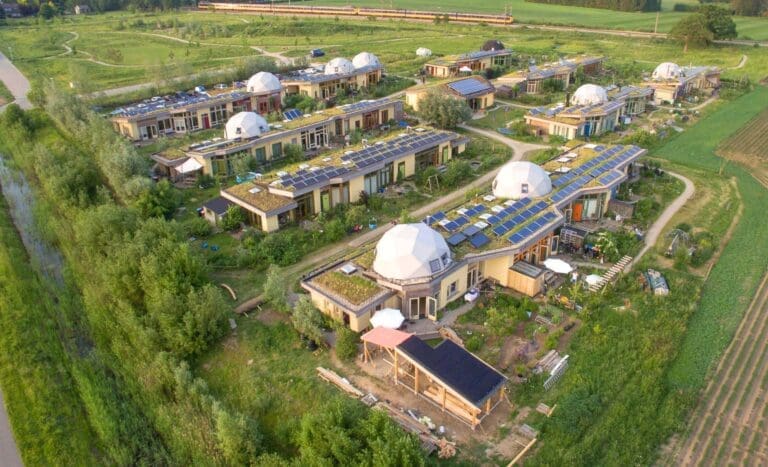Smart farming is revolutionizing the global agricultural sector by integrating cutting-edge technologies to elevate productivity, foster sustainability, and maximize efficiency across farming operations. As the agricultural industry grapples with challenges such as climate change, resource scarcity, and increasing demand for food, smart farming offers data-driven solutions tailored to individual farm needs while minimizing environmental impact.
Central to this transformation is the shift from automation—where machines “only” perform pre-programmed tasks—to autonomy, where intelligent systems adapt and make real-time decisions independently. This progression signifies the evolution of agricultural technology from simple mechanization to dynamic, self-reliant systems. Combined with the ideals of Solarpunk, which envisions a sustainable and harmonious coexistence of nature and technology, smart farming offers a blueprint for a greener, more equitable future.
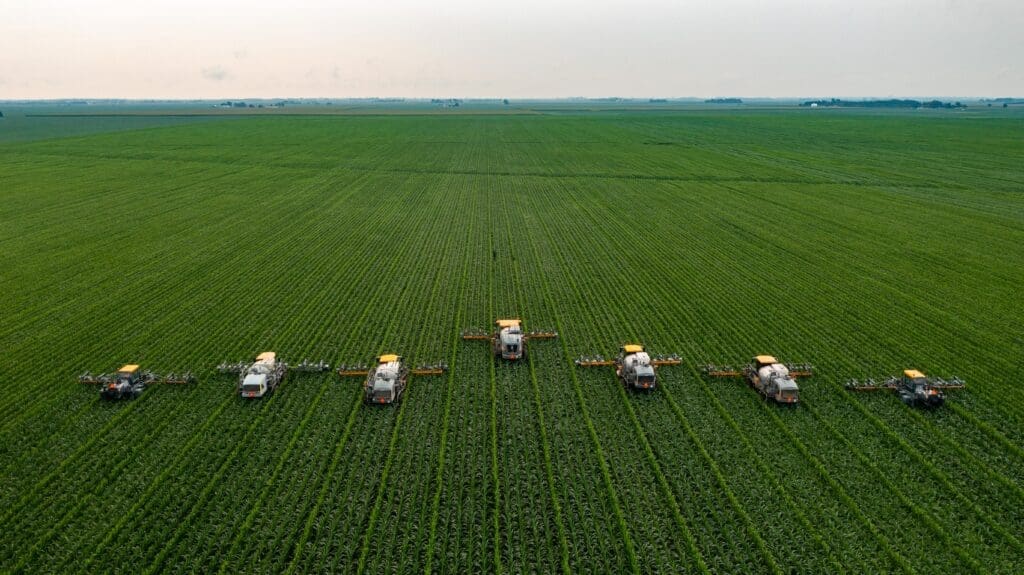
Why Smart Farming?
With the global population projected to reach 9.7 billion by 2050,[1] food production needs to increase by 70%.[2] However, traditional farming methods struggle with inefficiencies, resource overuse, and environmental degradation. The agricultural sector faces additional hurdles such as labor shortages, volatile weather patterns, and soil depletion. Smart farming addresses these challenges by developing and implementing technology-driven solutions that enhance productivity while promoting ecological balance.
Through precision techniques and real-time data monitoring, often paired with autonomous mobility (e.g., self-driving vehicles such as combine harvesters, tractors, seeders, ploughs, and weeders), smart farming ensures optimal use of resources like water, fertilizers, and energy, thereby reducing waste and environmental harm. Its capacity to integrate sustainability with advanced technology aligns seamlessly with global efforts to combat climate change and achieve food security.
Definition of Smart Farming
Smart farming refers to the application of advanced technologies like IoT (Internet of Things), AI (artificial intelligence), robotics, and big data analytics to monitor, analyze, and optimize agricultural operations. It represents a significant leap forward from traditional farming practices, enabling greater efficiency, sustainability, and scalability. The key components of smart farming include:
- Precision Agriculture: Tailored application of water, fertilizers, and pesticides based on real-time data
- IoT Sensors: Devices monitoring soil moisture, temperature, and crop health
- Drones and Satellites: Tools for aerial imaging and field mapping
- Automated Machinery: GPS-guided tractors and robotic harvesters
These technologies empower farmers to make informed, data-driven decisions, leading to increased yields, resource efficiency, and reduced environmental impact.
The evolution from automation to autonomy is central to the advancement of smart farming. While automation introduced mechanization and pre-programmed processes to farming, autonomy takes this a step further by enabling machines and systems to think, learn, and adapt independently. Autonomous agricultural systems can respond to real-time changes in crop or environmental conditions without requiring human intervention.
Why Move Toward Autonomy?
Automated systems, such as tractors and irrigation systems, have improved efficiency but lack the ability to adapt dynamically to variables like weather changes, pest infestations, or unexpected field conditions. Autonomous systems address these limitations by combining AI, machine learning, and advanced sensors to recognize patterns and trends in order to make precise, real-time adjustments—thus optimizing farming processes and reducing resource wastage.
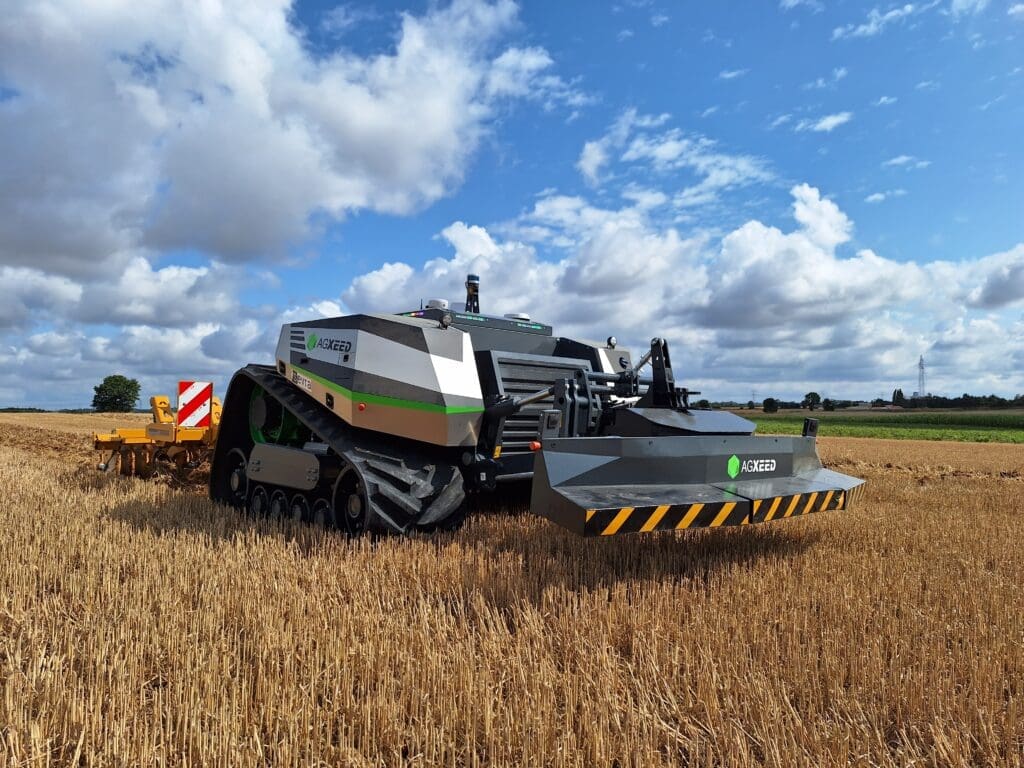
Current Achievements
- Autonomous Tractors: Companies like John Deere[3] and AgXeed[4] have developed autonomously driving tractors equipped with GPS, AI, and lidar technologies. These tractors can navigate fields, avoid obstacles, and optimize fuel efficiency independently. While many tractors continue to rely on fossil fuels and conventional powertrains, or hybrid systems like diesel-electric, Monarch[5] is leading the way by offering the world’s first fully electric autonomous tractor.
Applications are manifold, ranging from ploughing, seeding, hoeing, weeding, and making furrows to harvesting, providing assistance, and transportation.
- AI-Powered Robots: Startups like Naïo Technologies have created robots capable of distinguishing crops from weeds, enabling precise weeding. Naïo also offers viticulture solutions to assist with time-consuming and arduous tasks among the vines.[6]
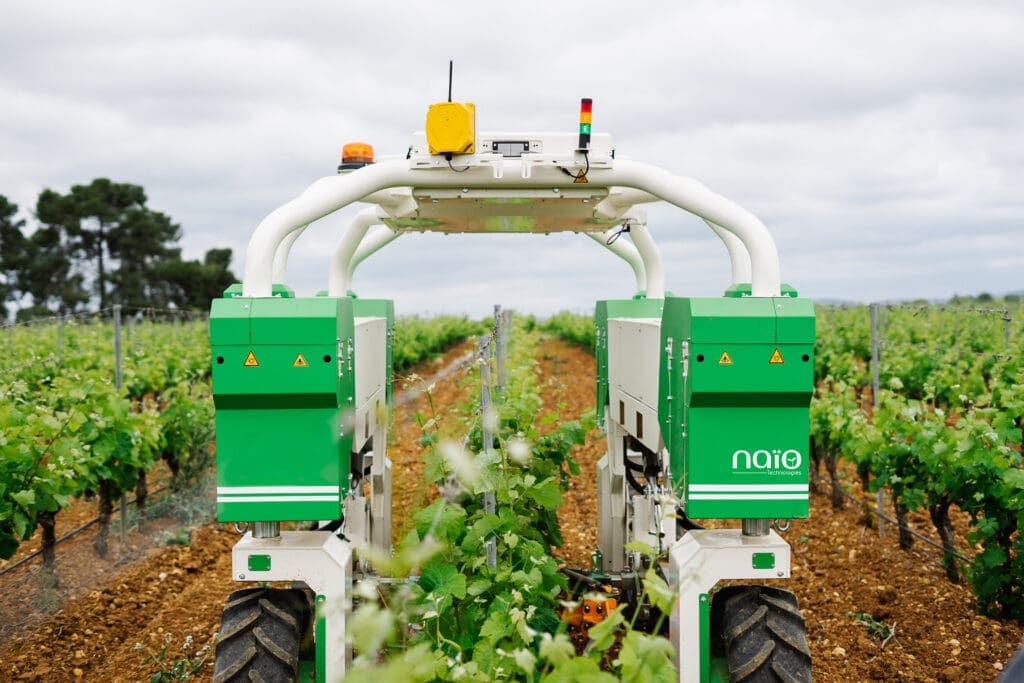
- Autonomous Drones: AI-equipped drones can autonomously perform tasks such as crop spraying and monitoring. They can also help identify animals like fawns hidden in fields, allowing humans to relocate them or enabling tractors to be rerouted to avoid them.
- Big Data: Big data in agriculture integrates weather data, satellite imagery, sensor information, drone visuals, market trends, genomic insights, and IoT-connected devices to optimize farming practices. These data sources provide detailed analysis, enabling farmers as well as AI to make decisions about irrigation, crop health, and resource management while promoting efficiency and sustainability in the agricultural industry. For instance, a California winery implemented a cloud-based solution that utilizes several of the previously mentioned data types to evaluate vine stress. Based on that, customized irrigation recommendations are given, resulting in a 26% increase in yields and a 16% reduction in water usage.[7]
As machine learning and robotics continue to evolve, autonomy will become a cornerstone of agricultural innovation, driving sustainability and efficiency. These advancements will also pave the way for fully automated farms that require minimal human intervention.
Smart Farming Work Flow
Smart farming systems operate through a seamless integration of technologies that work together to optimize farm operations. However, the process forms the backbone of it all, while digitization and technology enable its execution. The following is a high-level workflow, which must be adjusted to fit each specific use case:
- Data Collection: Sensors and IoT devices gather data on soil health, weather patterns, and crop conditions
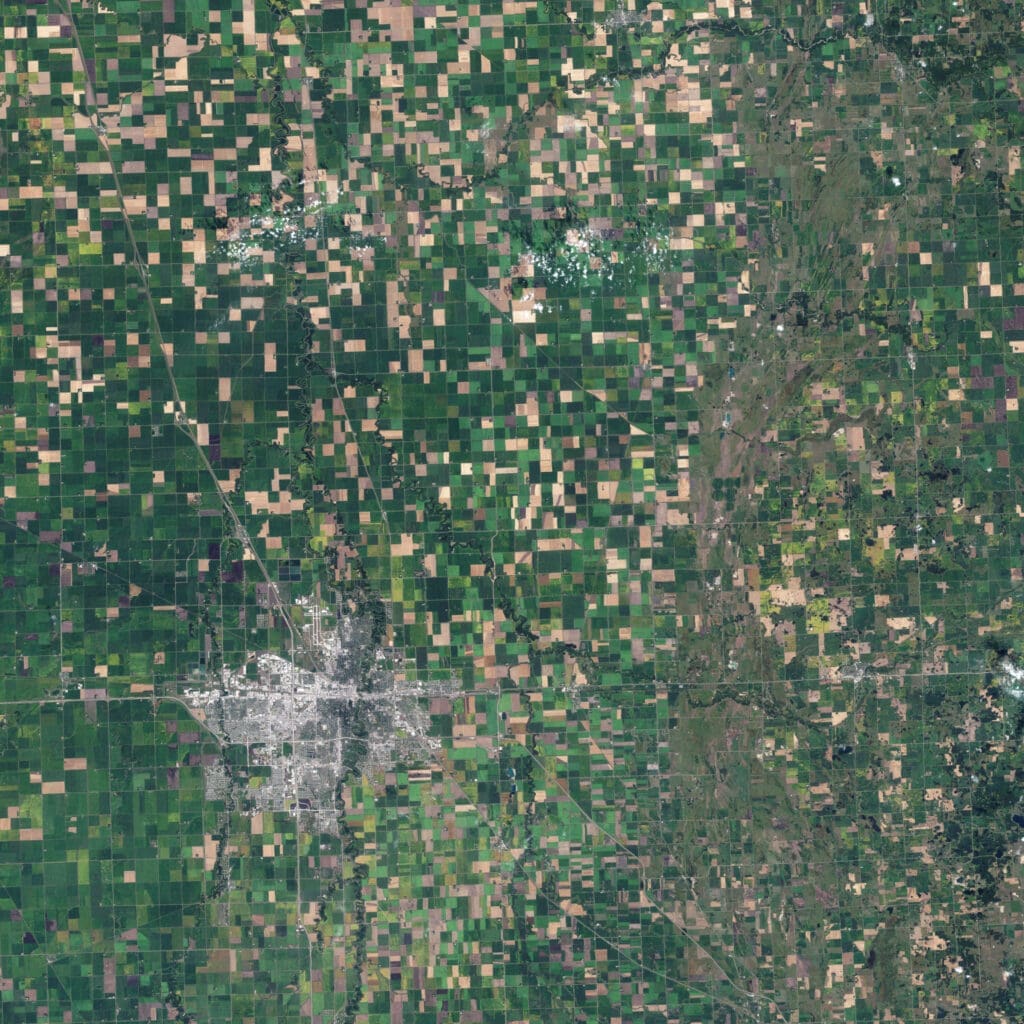
- Data Analysis: AI algorithms process this data to generate actionable insights
- Implementation: Autonomous machinery executes tasks like planting, weeding, irrigation, and harvesting based on data-driven recommendations
- Monitoring: Feedback systems enable real-time adjustments to ensure optimal outcomes
This interconnected framework ensures precision, adaptability, and sustainability, allowing farmers to achieve higher productivity with fewer resources.
Solarpunk and Smart Farming
Smart farming embodies Solarpunk values by integrating ecological principles with technological innovation. Its contributions to Solarpunk include:
- Renewable Energy Integration: The use of IoT sensors, drones, and autonomous machinery powered by renewable energy minimizes reliance on fossil fuels
- Sustainable Practices: Precision techniques minimize resource use, while reduced chemical inputs like herbicides protect ecosystems. Predictive analytics enhance efficiency by anticipating challenges in advance, enabling the implementation of proactive measures.
Through its focus on sustainability and innovation, smart farming serves as both a practical solution to current agricultural challenges and an inspiring model for a brighter, greener future.
Quantifiable Achievements
Smart farming has delivered impressive and measurable results:
- Resource Efficiency: Smart irrigation systems reduce water usage by up to 25 % boost crop yields by 20-30%.[8] Enhanced vision analytics allow for a localized application of chemicals (“See & Spray”), reducing usage by 70–80%.[9]
- Cost Savings: Worldwide farming operating costs could drop by 22%[10]
- Environmental Protection: Smart Farming lowers the use of pesticides and herbicides, minimizing soil and water pollution while promoting farming practices that are more animal-friendly.
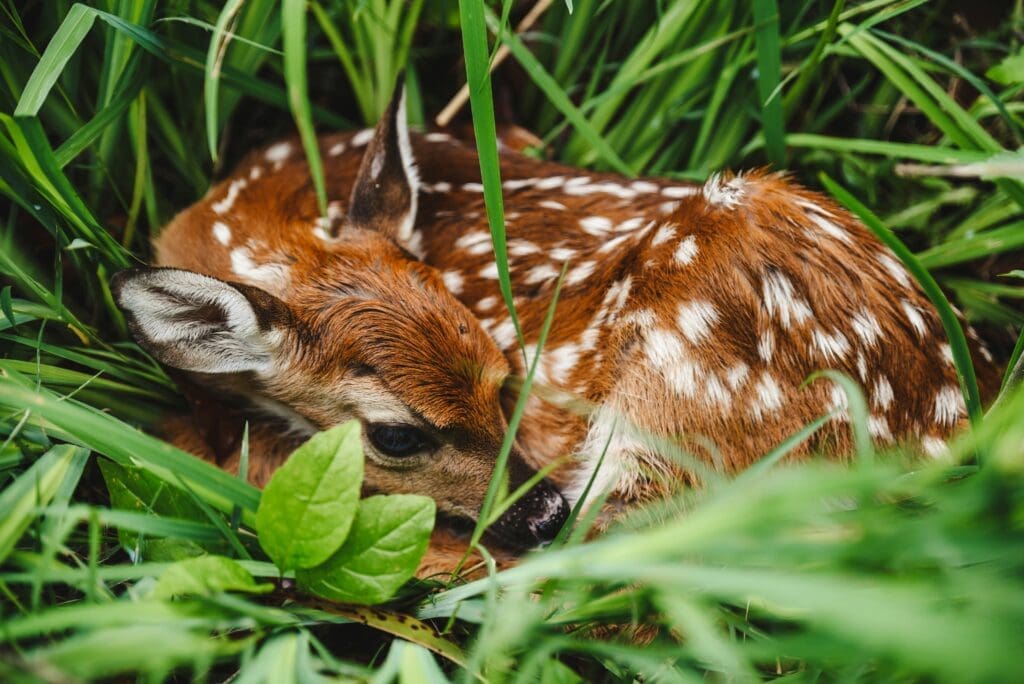
Market Growth
The global market for smart agriculture is projected to expand significantly, increasing from around 15 billion USD in 2022 to an estimated 33 billion USD by 2027.[11] The clientele ranges from smallholder farmers adopting IoT tools to large-scale enterprises investing in fully autonomous systems.
Conclusion
Smart farming represents the next frontier in agriculture, bridging the gap between technology and sustainability to address pressing global challenges. The transition from automation to autonomy, combined with its resonance with Solarpunk ideals, positions it as a transformative force shaping a future-proof farming. By harmonizing technology with ecological stewardship, smart farming offers a hopeful vision for a sustainable, efficient, and equitable agricultural landscape.
Sources:
[1] https://population.un.org/wpp/graphs?loc=900&type=Demographic%20Profiles&category=Line%20Charts
[2] https://www.fao.org
[3] https://www.deere.com/en/autonomous/
[4] https://www.agxeed.com/
[5] https://www.monarchtractor.com/
[6] https://www.naio-technologies.com/en/naio-technologies/
[7] https://www.ibm.com/think/topics/smart-farming
[8] https://www.keymakr.com/blog/precision-irrigation-how-ai-can-optimize-water-usage-in-agriculture/
[9] https://www.foodindustry.com/articles/smart-farming-how-iot-and-ai-are-revolutionizing-agriculture/
[10] https://www.futurefarming.com/smart-farming/will-ai-and-precision-agriculture-lower-farming-costs/
[11] https://www.statista.com/topics/4134/smart-agriculture/





